A Strategic Process to Manage Collaborative Risks in Supply Chain Networks (SCN) to Improve Resilience and Sustainability
Abstract
:1. Introduction
2. Literature Review
2.1. Supply Chain Networks
2.2. Risk Management
2.3. Network Analysis
2.4. Collaborative Risks
3. Materials and Methods
3.1. Development of the Strategic Process Proposed in This Work
3.2. Implementation to the Strategic Process Proposed in This Work
4. Case Study
4.1. Introduction
4.2. Application of the Strategic Process
5. Conclusions
6. Academic, Managerial and Ethical and Legal Implications
6.1. Academic Implications
6.2. Managerial Implications
6.3. Ethical and Legal Implications
7. Suggestions for Future Research
Author Contributions
Funding
Institutional Review Board Statement
Informed Consent Statement
Data Availability Statement
Conflicts of Interest
References
- Nunes, M.; Abreu, A. Applying Social Network Analysis to Identify Project Critical Success Factors. Sustainability 2020, 12, 1503. [Google Scholar] [CrossRef] [Green Version]
- Rajak, S.; Mathiyazhagan, K.; Agarwal, V.; Sivakumar, K.; Kumar, V.; Appolloni, A. Issues, and analysis of critical success factors for the sustainable initiatives in the supply chain during COVID-19 pandemic outbreak in India: A case study. Res. Trans. Econ. 2021; in press. [Google Scholar]
- Shen, Y.; Yang, F.; Habibullah, M. Predicting tool wear size across multi-cutting conditions using advanced machine learning techniques. J. Intell. Manuf. 2021, 32, 1753–1766. [Google Scholar] [CrossRef]
- World Economic Forum (WEF). How to Rebound Stronger from COVID-19—Resilience in Manufacturing and Supply Systems. April 2020. Available online: https://fr.weforum.org/whitepapers/how-to-rebound-stronger-from-covid-19-resilience-in-manufacturing-and-supply-systems (accessed on 1 January 2022).
- Nunes, M.; Abreu, A.; Bagnjuk, J. A Model to Manage Organizational Collaborative Networks in a Pandemic (COVID-19) Context. In Smart and Sustainable Collaborative Networks 4.0, Proceedings of the PRO-VE 2021 IFIP Advances in Information and Communication Technology, France, 22–24 November 2021; Camarinha-Matos, L.M., Boucher, X., Afsarmanesh, H., Eds.; Springer: Cham, Switzerland, 2021; Volume 629. [Google Scholar]
- Nunes, M.; Bagnjuk, J.; Abreu, A.; Saraiva, C.; Nunes, E.; Viana, H. Achieving Competitive Sustainable Advantages (CSAs) by Applying a Heuristic-Collaborative Risk Model. Sustainability 2022, 14, 3234. [Google Scholar] [CrossRef]
- Arena, M. Adaptive Space: How GM and Other Companies Are Positively Disrupting Themselves and Transforming into Agile Organizations; McGraw Hill Education: New York, NY, USA, 2018. [Google Scholar]
- Workday Studios. Good Company—Michael Arena, Chris Ernst, Greg Pryor: Organizational Networks. 2018. Available online: https://www.youtube.com/watch?v=6faV0v0yVFU (accessed on 12 January 2022).
- Nunes, M.; Abreu, A. Applying social network analysis to support the management of cooperative project’s behavioral risks. FME Trans. 2021, 49, 795–805. [Google Scholar] [CrossRef]
- Heinicke, M. Strategic process for Resilient Production Systems. In Advances in Production Management Systems. Innovative and Knowledge-Based Production Management in a Global-Local World, Proceedings of the APMS 2014 IFIP Advances in Information and Communication Technology; Grabot, B., Vallespir, B., Gomes, S., Bouras, A., Kiritsis, D., Eds.; Springer: Berlin, Heidelberg, 2014; Volume 440. [Google Scholar]
- Arena, M.; Cross, R.; Sims, J.; Uhl-Bien, M. How to Catalyze Innovation in Your Organization. Available online: https://www.robcross.org/wp-content/uploads/2020/03/SMR-how-to-catalyze-innovation-in-your-organization-connected-commons.pdf (accessed on 29 January 2022).
- Johansen, C.; Winroth, M. Coordination in collaborative manufacturing mega-networks: A case study. J. Eng. Technol. Manag. 2005, 22, 226–244. [Google Scholar] [CrossRef]
- Cheng, Y.; Farooq, S.; Johansen, J. International manufacturing network: Past, present, and future. Int. J. Op. Product. Manag. 2015, 35, 392–429. [Google Scholar] [CrossRef]
- Rudberg, M.; Olhager, J. Supply chain networks and supply chains: An operations strategy perspective. Omega 2003, 31, 29–39. [Google Scholar] [CrossRef]
- Nunes, M.; Abreu, A.; Saraiva, C. Identifying Project Corporate Behavioral Risks to Support Long-Term Sustainable Cooperative Partnerships. Sustainability 2021, 13, 6347. [Google Scholar] [CrossRef]
- Saraiva, C.; Mamede, H.S.; Silveira, M.C.; Nunes, M. Transforming Physical Enterprise into a Remote Organization: Transformation Impact: Digital Tools, Processes, and People. In Proceedings of the 2021 16th Iberian Conference on Information Systems and Technologies (CISTI), Madrid, Spain, 22–25 June 2021; pp. 1–5. [Google Scholar]
- Nunes, M.; Abreu, A.; Bagnjuk, J.; D’Onfrio, V.; Saraiva, C. A Heuristic Model to Identify Organizational Collaborative Critical Success Factors (CSFs). In Proceedings of the 2021 6th International Young Engineers Forum (YEF-ECE), Caparica, Portugal, 9 July 2021; pp. 63–68. [Google Scholar]
- McKenzie. Supply-Chain Recovery in Coronavirus Times—Plan for Now and the Future. Available online: https://www.mckinsey.com/business-functions/operations/our-insights/supply-chain-recovery-in-coronavirus-times-plan-for-now-and-the-future?cid=other-eml-alt-mip-mck&hlkid=53e98fdcbca84440a9da62b8aa318d06&hctky=11800216&hdpid=8044609a-0e2e-4a2a-9818-d7877df47684 (accessed on 1 January 2022).
- Nunes, M.; Abreu, A. Managing Open Innovation Project Risks Based on a Social Network Analysis Perspective. Sustainability 2020, 12, 3132. [Google Scholar] [CrossRef]
- Skinner, W. Manufacturing—Missing link in corporate strategy- discussing how to configure and organize manufacturing operations within the well-defined factory entity. Harv. Bus. Rev. 1969, 49, 136–145. [Google Scholar]
- Henry, D.; Verma, D. Usefulness of the Human Body as a Metaphor to Study the Resilience of Systems and Enterprises: A Preliminary Investigation. In Proceedings of the 7th Annual Conference on Systems Engineering Research 2009 (CSER 2009), Loughborough, UK, 20–23 April 2009. [Google Scholar]
- Kamalahmadi, M.; Parast, M. An assessment of supply chain disruption mitigation strategies. Int. J. Product. Econ. 2017, 184, 210–230. [Google Scholar] [CrossRef] [Green Version]
- Hajmirfattahtabrizi, M.; Song, H. Investigation of Bottlenecks in Supply Chain System for Minimizing Total Cost by Integrating Manufacturing Modelling Based on MINLP Approach. Appl. Sci. 2019, 9, 1185. [Google Scholar] [CrossRef] [Green Version]
- Yuhong, L.; Zobel, C. Exploring supply chain network resilience in the presence of the ripple effect. Int. J. Product. Econ. 2020, 228, 107693. [Google Scholar]
- Nunes, M.; Abreu, A.; Saraiva, C. A Model to Manage Cooperative Project Risks to Create Knowledge and Drive Sustainable Business. Sustainability 2021, 13, 5798. [Google Scholar] [CrossRef]
- ISO—The International Organization for Standardization. Available online: https://www.iso.org/home.html (accessed on 10 March 2022).
- Durland, M.; Fredericks, K. An introduction to social network analysis. New Dir. Eval. 2006, 2005, 5–13. [Google Scholar] [CrossRef]
- Abreu, A.; Nunes, M. Model to Estimate the Project Outcome’s Likelihood Based on Social Networks Analysis. KnE Eng. 2020, 5, 299–313. [Google Scholar] [CrossRef]
- Nunes, M.; Abreu, A. A Model to Support OI Collaborative Risks Applying Social Network Analysis. In Boosting Collaborative Networks 4.0, Proceedings of the PRO-VE 2020. IFIP Advances in Information and Communication Technology, Valencia, Spain, 23–25 November 2020; Camarinha-Matos, L.M., Afsarmanesh, H., Ortiz, A., Eds.; Springer: Cham, Switzerland, 2020; Volume 598. [Google Scholar]
- Nunes, M.; Abreu, A. The Benefits of Applying Social Network Analysis to Identify Collaborative Risks. In Technological Innovation for Applied AI Systems, Proceedings of the DoCEIS 2021 IFIP Advances in Information and Communication Technology, Caparica, Portugal, 7–9 July 2021; Camarinha-Matos, L.M., Ferreira, P., Brito, G., Eds.; Springer: Cham, Switzerland, 2021; Volume 626. [Google Scholar]
- Mead, S. Using social network analysis to visualize project teams. Proj. Manag. J. 2001, 32, 32–38. [Google Scholar] [CrossRef]
- Wasserman, S.; Faust, K. Social Network Analysis in the Social and Behavioral Sciences. In Social Network Analysis: Methods and Applications; Cambridge University Press: Cambridge, MA, USA, 1994; pp. 1–27. ISBN 9780521387071. [Google Scholar]
- Nunes, M.; Abreu, A.; Bagnjuk, J.; Tiedtke, J. Measuring project performance by applying social network analyses. Int. J. Innov. Stud. 2021, 5, 35. [Google Scholar] [CrossRef]
- Prell, C.; Hubacek, K.; Reed, M. Stakeholder analysis and social network analysis in natural resource management. Soc. Nat. Resour. 2009, 22, 501–518. [Google Scholar] [CrossRef]
- Mok, K.; Shen, G.; Yang, R.; Li, C. Investigating key challenges in major public engineering projects by a network-theory based analysis of stakeholder concerns: A case study. Int. J. Proj. Manag. 2017, 35, 78–94. [Google Scholar] [CrossRef]
- Mitchell, J. Social Network Analysis for Organizations, 4th ed.; Tichy, N.M., Tushman, M.L., Fombrun, C., Eds.; Academy of Management Review: Briarcliff Manor, NY, USA, 1979; pp. 507–519. [Google Scholar]
- Meyer, M.; Roodt, G.; Robbins, M. Human resources risk management: Governing people risks for improved performance. SA J. Hum. Resour. Manag. 2011, 9, 366. [Google Scholar] [CrossRef] [Green Version]
- Borgatti, S.; Everett, M.; Johnson, J. Analyzing Social Networks, 2nd ed.; UK Sage Publications Ltd.: Thousand Oaks, CA, USA, 2017. [Google Scholar]
- Brass, J.; Borgatti, P. Social Networks at Work (SIOP Organizational Frontiers Series), 1st ed.; Routledge Publisher: New York, NY, USA, 2020. [Google Scholar]
- Cross, R.; Rebele, R.; Grant, A. Collaborative Overload. Harv. Bus. Rev. 2016, 94, 74–79. [Google Scholar]
- Ruan, X.; Ochieng, P.; Price, A. The Evaluation of Social Network Analysis Application’s in the UK Construction Industry, Proceedings of the 27th Annual ARCOM Conference, Bristol, UK, 5–7 September 2011; Association of Researchers in Construction Management ARCOM: London, UK, 2011. [Google Scholar]
- Krackhardt, D.; Hanson, J. Informal Networks the Company behind the Charts; Harvard College Review: Cambridge, MA, USA, 1993; Available online: https://hbr.org/1993/07/informal-networks-the-company-behind-the-chart (accessed on 5 March 2022).
- Freeman, L. Centrality in social networks conceptual clarification. Soc. Netw. 1979, 1, 215–239. [Google Scholar] [CrossRef] [Green Version]
- Nunes, M.; Bagnjuk, J.; Abreu, A.; Cardoso, E.; Smith, J.; Saraiva, C. Creating Actionable and Insightful Knowledge Applying Graph-Centrality Metrics to Measure Project Collaborative Performance. Sustainability 2022, 14, 4592. [Google Scholar] [CrossRef]
- Edmondson, A. Psychological Safety and Learning Behavior in Work Teams. Admin. Sci. Quart. 1999, 44, 350–383. [Google Scholar] [CrossRef] [Green Version]
- Kirby, E.; Muroy, S.; Sun, W.; Covarrubias, D.; Leong, M.; Barchas, L.; Kaufer, D. Acute stress enhances adult rat hippocampal neurogenesis and activation of newborn neurons via secreted astrocytic FGF2. eLife 2013, 2, e00362. [Google Scholar] [CrossRef]
- Bailey, R.; Raelin, J. Organizations Don’t Resist Change, People Do: Modeling Individual Reactions to Organizational Change Through Loss and Terror Management. Organ. Manag. J. 2015, 12, 125–138. [Google Scholar] [CrossRef]
- Watzek, J.; Pope, S.; Brosnan, S. Capuchin, and rhesus monkeys but not humans show cognitive flexibility in an optional-switch task. Sci. Rep. 2018, 9, 13195. [Google Scholar] [CrossRef]
- Kontinen, T.; Ojala, A. Network ties in the international opportunity recognition of family SMEs. Int. Bus. Rev. 2011, 20, 440–453. [Google Scholar] [CrossRef] [Green Version]
- Ng, D.; Law, K. Impacts of informal networks on innovation performance: Evidence in Shanghai. Chin. Manag. Stud. 2015, 9, 56–72. [Google Scholar] [CrossRef]
- Narsalay, R.; Kavathekar, J.; Light, D. A Hands-Off Approach to Open Innovation Does Not Work. Available online: https://hbr.org/2016/05/a-hands-off-approach-to-open-innovation-doesnt-work (accessed on 4 March 2022).
- Ophir, E.; Nass, C.; Wagner, D. Cognitive control in media multitaskers. Proc. Natl. Acad. Sci. USA 2009, 106, 15583–15587. [Google Scholar] [CrossRef] [PubMed] [Green Version]
- United Nations (UN). The 17 Sustainable Development Goals (SDGs). Available online: https://sdgs.un.org/goals (accessed on 8 March 2022).
- GDPR—Data Protection, Rules for the Protection of Personal Data Inside and Outside the EU. Available online: https://ec.europa.eu/info/law/law-topic/data-protection_en (accessed on 7 January 2022).
- Dutta, G.; Kumar, R.; Sindhwani, R. Digitalization priorities of quality control processes for SMEs: A conceptual study in perspective of Industry 4.0 adoption. J. Intell. Manuf. 2021, 32, 1679–1698. [Google Scholar] [CrossRef]

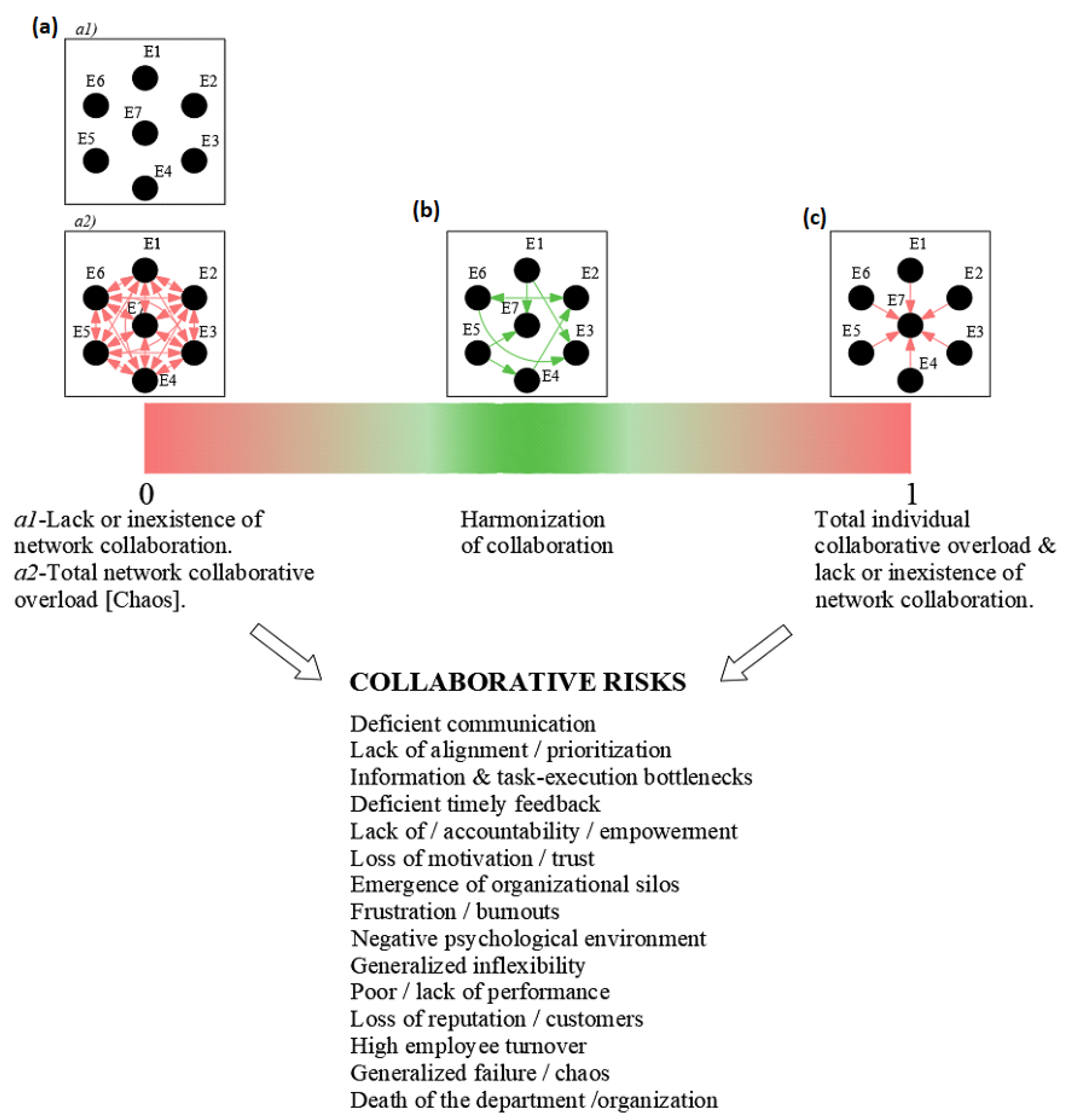

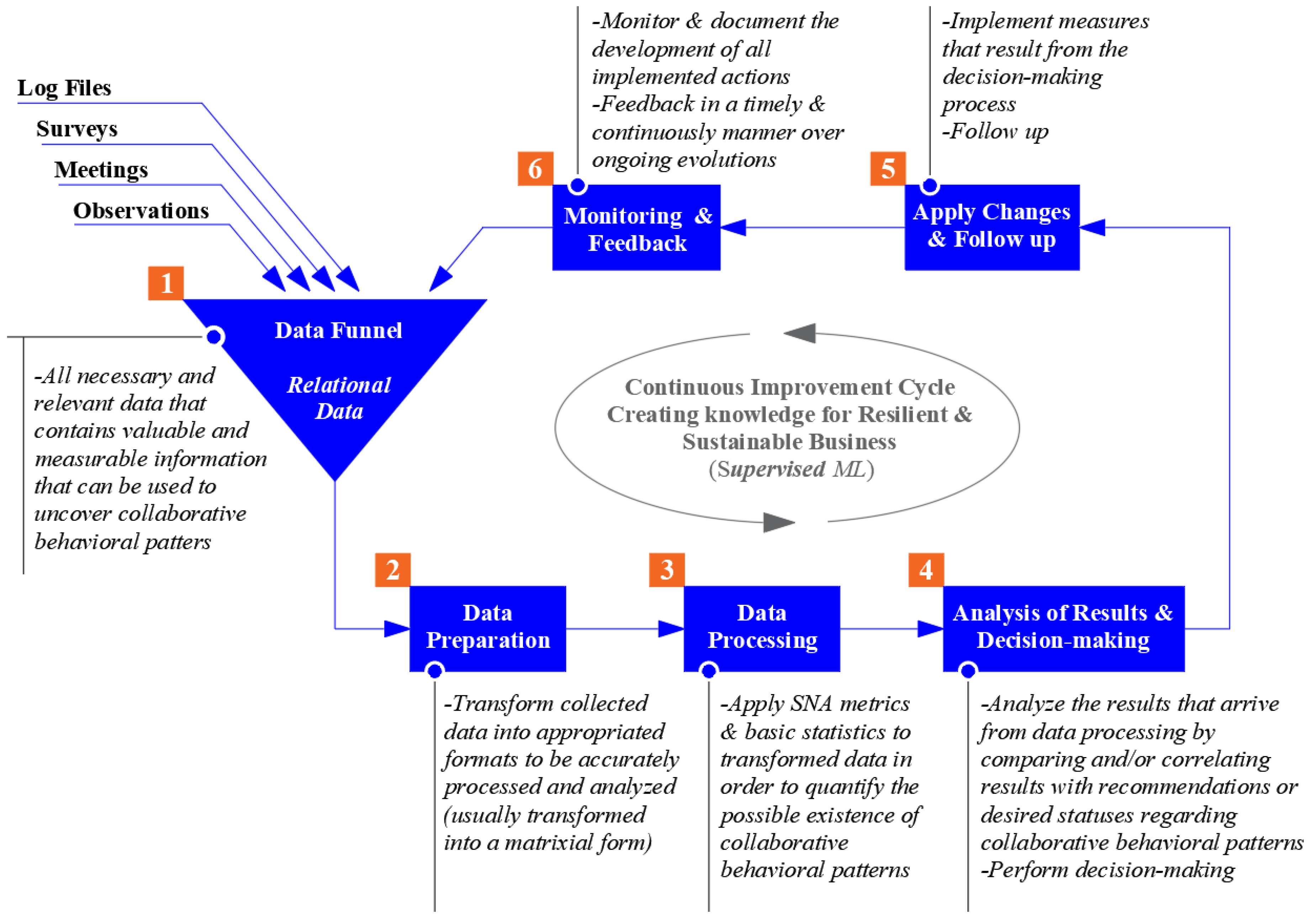
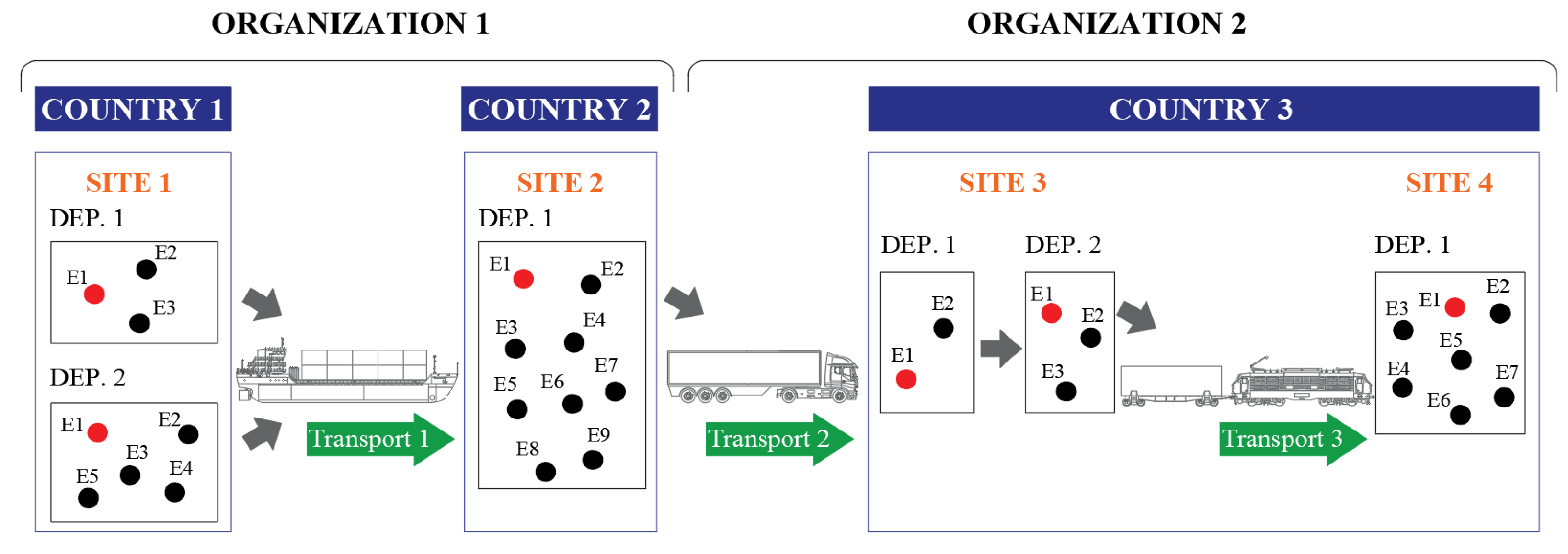
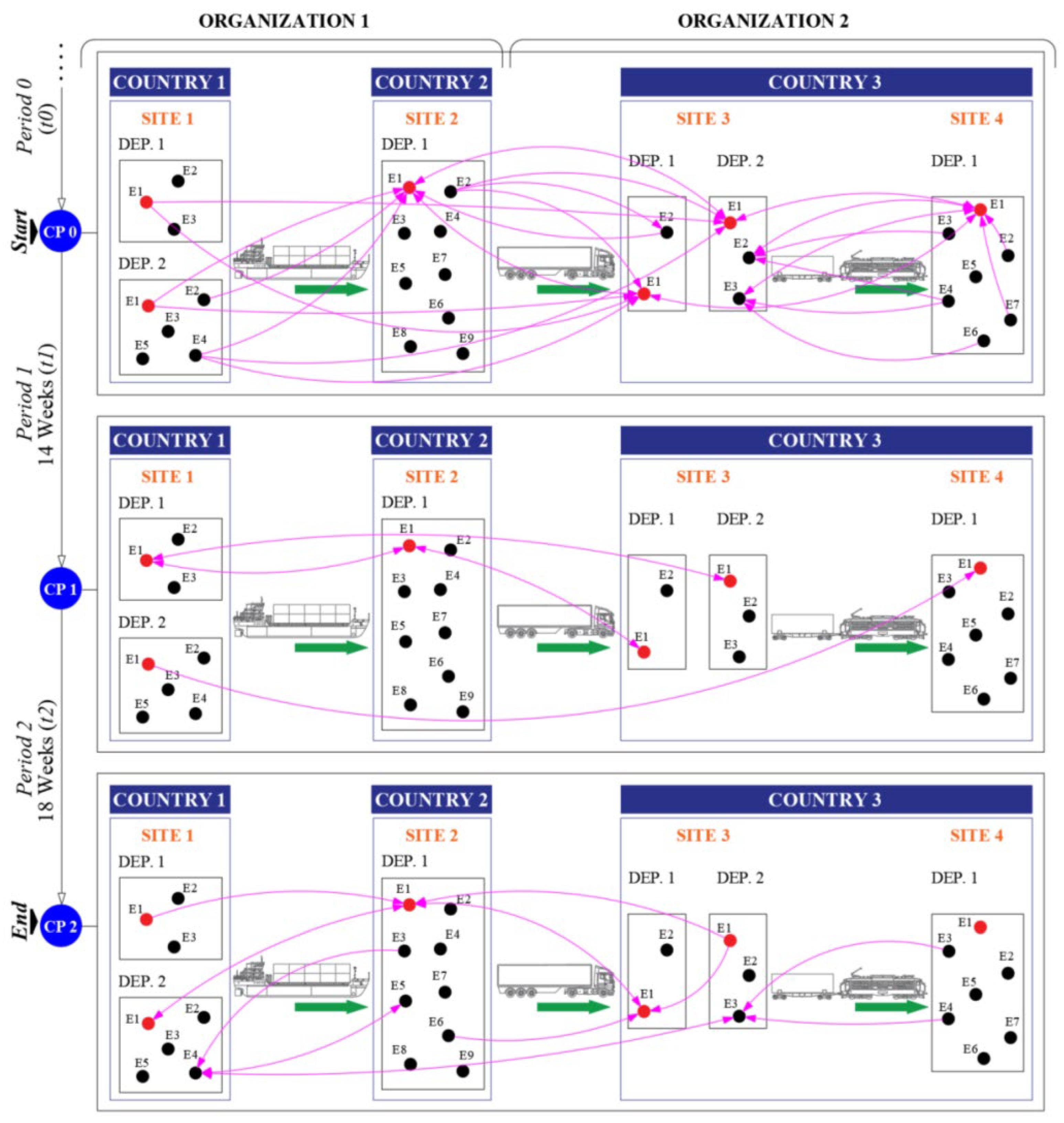


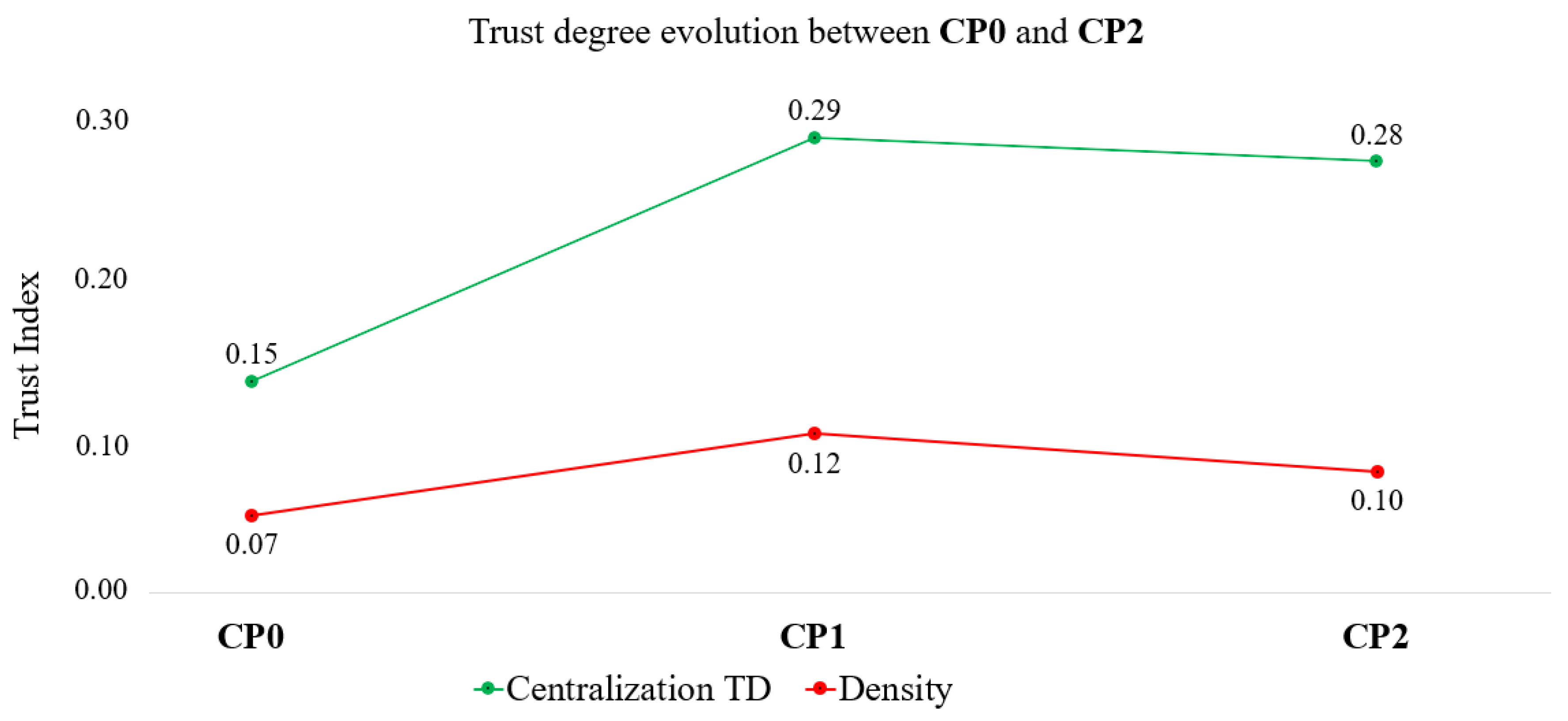
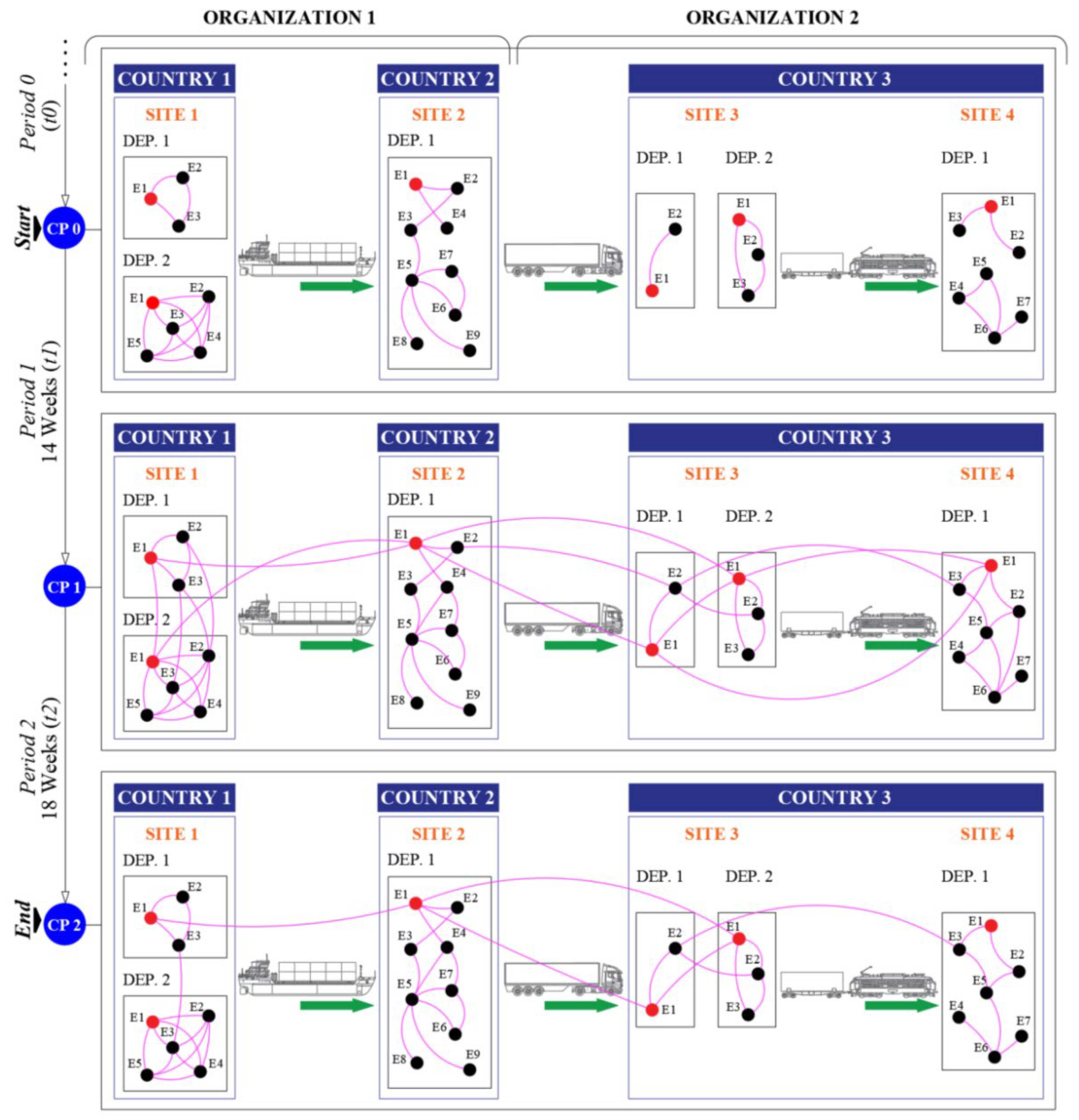


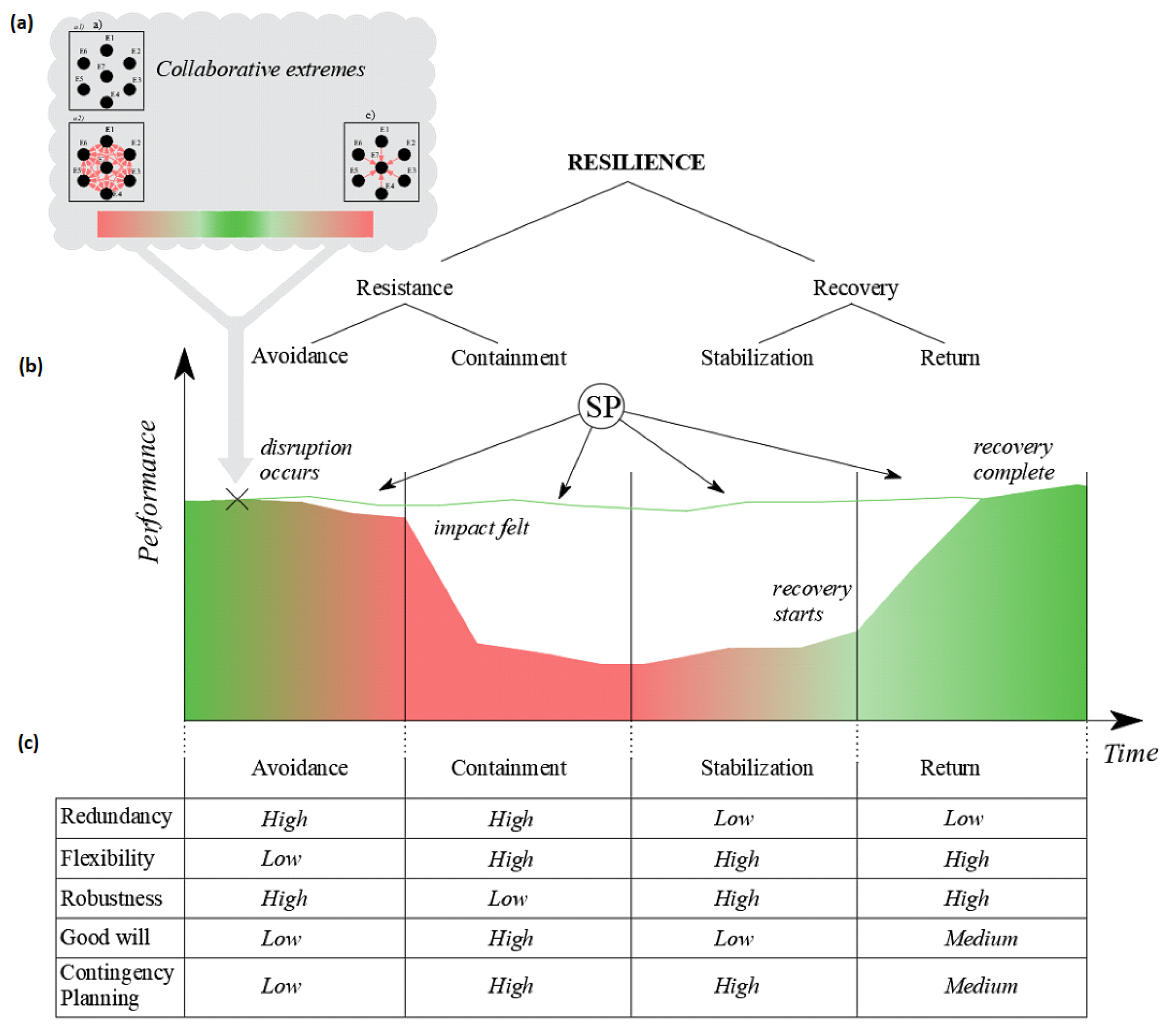
|
| |
|---|---|---|
| Single Site | Multiple Site | |
| Single organization (Manufacturing Network) |
|
|
| Multi-organization (Supply-chain Network) |
|
|
| Supply chain networks | This pillar contributes to the strategic process with the definitions, terminology, characteristics, and structure of SCN. It includes the specificities of a manufacturing network (characterization regarding the number of organizations and number of sites) as well as the major issues associated to operational environment, such as the most appropriated management approach to manage collaborative risks, and the physical design of a manufacturing network. |
| Risk Management | This pillar contributes to the strategic process with the “best practice approach” steps to perform risk management in organization. It has its foundations in the ISO 31000 risk management standard [26]. This standard provides the principal steps that an organization should adopt to efficiently perform the activities that comprises the process of risk management which includes major activities such as risk identification, risk analysis, risk mitigation, and risk treatment. |
| Social Network Analysis | This pillar contributes to the strategic process with the mathematical approach to quantitatively measure collaborative risks in SCNs. Essentially this pillar provides the metrics, which are based on graph theory [32], to uncover hidden behavioral patterns of collaboration that emerge and evolve across a given period within an organizational social network. The metrics provided by this pillar are essentially SNA centrality metrics, which according to several research studies [1,19,32,38,39] are the ones that better translates and correlates the myriad of relationships within a given organizational social network with outputs and outcomes. |
| Dimensions | Description and Objectives |
|---|---|
| (D1) Network Access (more access to) or Reach | Network access or reach respects the capacity that one entity within a social network must reach or access all the other entities within the same social network. In one side, if an entity of a social network has access to all the other entities of that same network it may be beneficial to the individual and the group because it may mean fast access to vital information to perform work efficiently and general well-being [1,8]. Simultaneously, it may also represent disorder and confusion because it may mean the existence of chaos and too much redundancy regarding work performance and well-being [1,8]. On the other side, poor or no access of an entity to another entity within the same social network may represent a threat to work performance and general well-being because it hinders the interaction level and thus information exchange, creation of bounds fostered by the mix of formal and informal relationships, just to name a few, resulting into a strong siloed organizational structure [1]. This may occur due to several factors, such as lack of time of some entities of a social network, cultural differences fear, lack of psychological safety and so on [45]. By mapping the network access (more access to) or reach, the strategic process will identify which elements are becoming critical (extremely central) for the information exchange process within a manufacturing network. This will enable to correlate arrangements visible in the mapping of this network with organizational outcomes and outputs. |
| (D2) Network Trust | The trust level within a given social network can characterize how efficient and with what frequency does information flows across the whole network [1]. Being trust a fundamental factor to efficiently spark organizational interactions [1,8], such as communication, learning, teaching, validation, problem solving, decision making, just to name a few, it is critical to ascertain the level of trust within a social network. Mapping the trust network of a manufacturing social network enables us to identify critical partners or subnetworks, whereby trust and support (translated into professional and personal) is established. Aspects, such as intensity, frequency, confidence, empowerment, and reliability, are entitled to be analyzed in the trust network [1,8,9,10,11]. |
| (D3) Network Communication | The mapping of the communication network in a manufacturing social network enables to analyze aspects related to how effective, efficient, and centralized (or de-centralized) communication takes place between the different elements that collaborate to accomplish organizational tasks or activities [1]. Aspects such as frequency, intensity, and broadness are analyzed [9]. In this case, only the communication channels under a given frequency between the different elements that comprise a manufacturing network will be analyzed. By doing so, one can identify communication bottlenecks, and the emerging of organizational silos. Furthermore, one can identify given elements within a manufacturing network that due to their structural position within the network, may be more susceptible to face damages (burnouts, frustration, among others), which may end by affecting the whole manufacturing social network [1,8,9,10,11]. |
| Risk Management Steps according to the ISO 31000:2018 | Proposed Strategic Process Equivalent Steps |
|---|---|
| Step 1: establish scope, context and criteria | Step 1, data funnel: Define target and collect relational information to map the three key manufacturing network’s collaborative dimensions (network access or reach, trust, and communication) |
| Step 2: risk identification | Step 2, data preparation: apply metrics to collected data, to quantitatively identify potential collaborative behavioral patterns risks |
| Step 3: risk analysis | Step 3, data processing: analyze the results and correlated them with work performance (outputs and outcomes) |
| Step 4: risk evaluation | Step 4, analysis of results and decision-making. evaluate the impact of identified collaborative risks in work related matters and decide the implementation of corrective or supportive measures |
| Step 5: risk treatment | Step 5, apply changes and follow up: implement decided corrective or supportive measures |
| Step 6: monitoring and reviewing | Step 6, monitoring and feedback: continuously monitor implemented measures and assess their effectiveness. Generate lessons learned |
| Dimensions | SNA Metric Description | |
|---|---|---|
| Network Access or Reach | Metric 1: Centralization degree index (undirected) CTD = Total degree of a given entity in a network g = Number of entities in a network n* = Entity with the highest in-degree in a network i = Entity 1, 2, 3,…, g Metric 2: Average in-degree index (directed) CID = In-degree of a given entity in a network Metric 3: Reciprocity degree index (directed) LB = Total number of reciprocal links within a network | Objective: Analyze the reach (also known as access) of the whole network. It quantifies how much or little access does individuals have to other individuals within an organizational social network function of their need or desire to improve the way they carry out their work. For this matter will be calculated the centralization degree (1), average in-degree (2) and reciprocity (3) indexes. The centralization index varies from 0 (minimum) to 1 (maximum), where 0 means that a network is totally not centralized around one entity, and 1 means that the network is fully centralized around only one entity. The average in-degree characterizes how many links do entities of a network have in average toward the other entities of that same network. It varies from 0 (meaning that there are no links between any entities of a network) to 1 (meaning that all entities of a network have a link to the remaining entities of that same network). The reciprocity index characterizes how many bi-directional links exist within a social network. It varies from 0 (meaning that there are no reciprocal links) to 1 (meaning that all links are reciprocal). |
| Trust | Metric 1: see (1) Metric 2: Density (undirected) L = Total number of all links within a network | Objective: Analyze the trust level of an organization social network, and thus deduce its knowledge-transfer potential, once interactions such as providing help, support, advice, information transfer take place. This happens more efficiently if the element trust is present. |
| Communication | Metric 1: see (1) Metric 2: (4) | Objective: Analyze the frequency of and quantify the number of communication channels of an organizational social network. For this matter will be calculated the density of an organizational communication social network. The density varies between (1) and (0), representing a full connected social network regarding the communication channels and the inexistence of any communication channel, respectively. |
Publisher’s Note: MDPI stays neutral with regard to jurisdictional claims in published maps and institutional affiliations. |
© 2022 by the authors. Licensee MDPI, Basel, Switzerland. This article is an open access article distributed under the terms and conditions of the Creative Commons Attribution (CC BY) license (https://creativecommons.org/licenses/by/4.0/).
Share and Cite
Nunes, M.; Abreu, A.; Bagnjuk, J.; Nunes, E.; Saraiva, C. A Strategic Process to Manage Collaborative Risks in Supply Chain Networks (SCN) to Improve Resilience and Sustainability. Sustainability 2022, 14, 5237. https://doi.org/10.3390/su14095237
Nunes M, Abreu A, Bagnjuk J, Nunes E, Saraiva C. A Strategic Process to Manage Collaborative Risks in Supply Chain Networks (SCN) to Improve Resilience and Sustainability. Sustainability. 2022; 14(9):5237. https://doi.org/10.3390/su14095237
Chicago/Turabian StyleNunes, Marco, António Abreu, Jelena Bagnjuk, Edgar Nunes, and Célia Saraiva. 2022. "A Strategic Process to Manage Collaborative Risks in Supply Chain Networks (SCN) to Improve Resilience and Sustainability" Sustainability 14, no. 9: 5237. https://doi.org/10.3390/su14095237
APA StyleNunes, M., Abreu, A., Bagnjuk, J., Nunes, E., & Saraiva, C. (2022). A Strategic Process to Manage Collaborative Risks in Supply Chain Networks (SCN) to Improve Resilience and Sustainability. Sustainability, 14(9), 5237. https://doi.org/10.3390/su14095237








